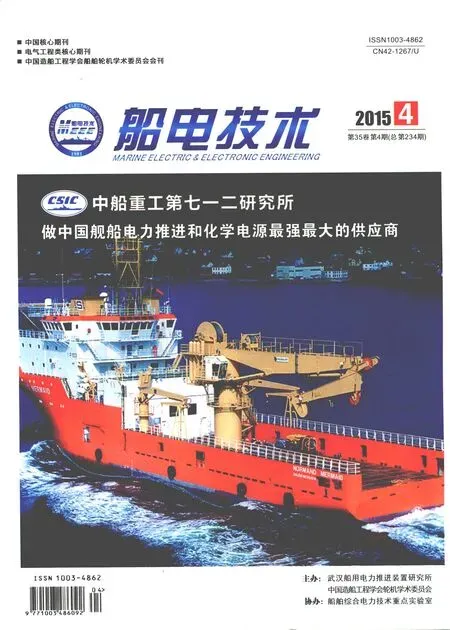可逆卡諾制冷機和熱泵的輸出率密度分析與優化
楊光明,朱朝峰,劉云海
(海軍駐武漢四三八廠軍事代表室,武漢 430061)
可逆卡諾制冷機和熱泵的輸出率密度分析與優化
楊光明,朱朝峰,劉云海
(海軍駐武漢四三八廠軍事代表室,武漢 430061)
以逆卡諾循環的輸出率密度(對循環最大比容平均的循環輸出率),即卡諾制冷機的制冷率密度和卡諾熱泵的供熱率密度作為熱力性能目標, 分別對內可逆卡諾制冷機和熱泵進行分析與優化,導出了最佳換熱器面積分配的關系式,計算分析了熱源溫比對輸出率密度與性能系數關系的影響。所得結果不同于以制冷率和供熱率為目標的優化結果,對裝置設計具有一定理論上的指導意義。
內可逆卡諾制冷機 內可逆卡諾熱泵 制冷率密度 供熱率密度
0 引言
自NoviKov、Chambadal、Curzon和Ahlborn等人分別導出了著名的CA效率[1-3]后,有限時間熱力學的研究取得了大量成果[4-7]。在對制冷機和熱泵循環的研究中,嚴子俊[8-9]和Goth[10]首先研究了卡諾制冷機及熱泵的基本優化關系。陳林根等[11]導出了卡諾制冷機的有限時間火 用 經濟性能界限、優化關系和優化準則,并建立了制冷機的生態學優化目標[12]。吳治、孫豐瑞、陳林根等[13-15]則研究了卡諾熱泵的比供熱率、生態學、經濟性。陳林根等[16-17]和朱小芹等[18-19]研究了傳熱規律對不可逆卡諾制冷機[16,18]和熱泵[17,19]性能的影響。1996年起,一些學者以對最大比容平均的功率輸出—功率密度為優化目標,研究了熱機循環的性能優化問題,兼顧了發動機的尺寸和效率[20-23]。Yavuz和Erbay最早用制冷率密度(即制冷率與循環最大比容之比)分別分析研究了Ericsson循環和Stirling循環[24-25],并得到了有意義的結果。進一步,周圣兵等[26]以制冷率密度為目標對內可逆空氣制冷機進行了分析與優化。本文將以逆卡諾循環的輸出率密度,即卡諾制冷機的制冷率密度和卡諾熱泵的供熱率密度作為熱力性能目標, 分別對內可逆卡諾制冷機和熱泵進行分析與優化,并與以輸出率為目標的研究結果進
行比較,所得結果兼顧了裝置的尺寸因素,具有一定理論上的指導意義。

圖1 內可逆卡諾制冷機、熱泵循環模型
1 循環描述
考慮如圖1所示的內可逆卡諾制冷機和熱泵循環模型, 假定該模型為定常態流,內可逆卡諾循環,兩恒溫熱源溫度分別為TH、TL,高、低溫側工質的溫度分別為THC、TLC;過程1-2為從TL熱源等溫吸熱過程,過程3-4為向TH熱源等溫放熱過程,2-3和4-1分別為絕熱壓縮和絕熱膨脹過程。
2 制冷機的制冷率、制冷率密度分析


3 熱泵的供熱率、供熱率密度分析


圖2 制冷率、制冷率密度與制冷系數的關系曲線

圖3 熱源溫比對制冷率密度性能的影響

圖4 供熱率、供熱率密度與供熱系數的關系曲線
圖1中,2點為循環比容最大點,則供熱率密度的解析式為



圖5 熱源溫比對供熱率密度性能的影響
4 小結
本文以輸出率密度為優化目標,研究內可逆卡諾制冷機和熱泵性能,著重討論了制冷機和熱泵的制冷率密度和供熱率密度與性能系數之間的關系,導出了換熱器面積分配的關系式,得到了不同于以傳統制冷率和供熱率為優化目標的新結果,具有一定理論上的指導意義。不可逆卡諾制冷機和熱泵的性能優化問題尚待進一步研究探討。
[1] Novikov I I. The efficiency of atomic power stations (A review) [J]. Atommaya Energiya 3, 1957(11): 409.
[2] Chambdal P. Les Centrales Nucleases[M]. Paris: Armand Colin, 1957(11): 41-58.
[3] Curzon F L, Ahlborn B. Efficiency of a carnot engine at maximum power output [J]. Am. J. Phys, 1975, 43(1): 22-24.
[4] Bejan A. Entropy generation minimization. The new thermodynamics of finite-size device and finite-time processes [J]. J. Appl. Phys, 1996, 79(3): 1191-1218.
[5] Berry R S, Kazakov V A, Sieniutycz S, Szwast Z, Tsirlin A M. Thermodynamic Optimization of Finite Time Processes [M]. Wiley, Chichester, 1999.
[6] Chen L, Sun F. Advances in finite time thermodynamics: Analysis and Optimization [M]. New York: Nova Science Publishers, 2004, p240.
[7] 陳林根. 不可逆過程和循環的有限時間熱力學分析[M]. 北京: 高等教育出版社, 2005, p280.
[8] 嚴子浚. 卡諾制冷機的最佳制冷系數與制冷率關系[J]. 物理, 1984, 13(12): 768-770.
[9] 嚴子浚. 內可逆卡諾熱泵的最優性能[J]. 廈門大學學報, 1984, 23(4): 414-419.
[10] Goth Y, Feidt M. Optimal COP for endoreversible heat pump or refrigerating machine [C]. C. R. Acd. Sc. Pairs, 1986, 303(1): 19-24.
[11] 陳林根, 孫豐瑞, 陳文振. 兩源間制冷機有限時間火用 經濟性能界限和優化準則[J].科學通報, 1990,35(23):1837.
[12] 陳林根, 孫豐瑞, 陳文振. 兩源制冷機的生態學優化準則[J]. 自然雜志, 1992, 15(8): 633.
[13] Wu C. Specific heating load of an endoreversible Carnot heat pump [J]. Int. J. Ambient Energy., 1993, 14(1): 25-28.
[14] Chen L, Wu C, Sun F. Heat pump performance with internal heat leak [J]. Int. J. Ambient Energy., 1997, 18(3): 129-134.
[15] Sun F, Chen W, Chen L, Wu C. Optimum performance of an endoreversible Carnot heat pump [J]. Energy Convers. Mgmt., 1997, 38(14): 1439-1443.
[16] Chen L, Sun F, Wu C. Effect of heat transfer law on the performance of a generalized irreversible Carnot refrigerator. J. Non-Equibri. Thermodyn., 2001, 26(3): 291-304.
[17] Chen L, Zhu X, Sun F, Wu C. Exergy-based ecological optimization for a generalized irreversible Carnot heat pump. Applied Energy, 2007, 84(1): 78-88.
[18] Zhu X, Chen L, Sun F, Wu C. Exergy based ecological optimization for a generalized irreversible Carnot refrigerator. J. of Energy Institute., 2006, 79(1): 42-46.
[19] Zhu X, Chen L, Sun F, Wu C. Effect of heat transfer law on the ecological optimization of a generalized irreversible Carnot heat pump. Int. J. Exergy., 2005, 2(4): 423-436.
[20] Sahin B, Kodal A, Yavuz H. Maximum power density analysis of an endoreversible Carnot heat engine [J]. Energy, The Int., 1996, 21(10): 1219-1225.
[21] Erbay L B, Sisman A, Yavuz H. Analysis of Ericsson cycle at maximum power density conditions. ECOS96, 1996: 25-27.
[22] Chen L, Lin J, Sun F, Wu C. Efficiency of an Atkinson engine at maximum power density. Energy Convers. Mgmt., 1998, 39(3/4): 337-341.
[23] Chen L, Zheng J, Sun F, Wu C. Power density analysis and optimization of a regenerated closed variable-temperature heat reservoir Brayton cycle. J. Phys. D: Appl. Phys., 2001, 34(11): 1727-1739.
[24] Yavuz H L, Erbay L B. General performance Characteristics of an Ericsson refrigerator [C]. ECOS98, Nancy, France, 1998: 565-571.
[25] Erbay L B, Yavuz H. The maximum cooling density of a realistic Stirling refrigerator [J]. J. Phys. D: Appl. Phys., 1998, 31(3): 291-293.
[26] Zhou S, Chen L, Sun F, Wu C. Cooling load density analysis and optimization for an endoreversible air refrigerator [J]. Open Systems & Information Dynamics., 2001, 8(2): 147-155.
Optimization of Output Load Density for Reservoir Endoreversible Carnot Refrigerator and Heat Pump
Yang Guangming, Zhu Chaofeng, Liu Yunhai
(Navy Deputy Office in No.438 Factory, Wuhan 430061,China)
The performance analysis and optimization of constant-temperature heat reservoir endoreversible Carnot refrigerator and heat pump is carried out by taking the output load density(the ratio of output load to the maximum specific volume in the cycle), i.e. the cooling load density and the heating load density as the optimization objective in this paper. The analytical expression for the optimal allocation of heat-exchanger area is derived. The effect of heat reservoir temperature ratio on the output load density is analyzed by detailed numerical examples. The results obtained are different from those with the cooling load and heating load objective and of theoretic significance to the design practice for future plants.
endoreversible Carnot refrigerator; endoreversible Carnot heat pump; cooling load density; heating load density
TB651
A
1003-4862(2015)04-0058-04
2014-12-10
楊光明(1982-),男,工程師。研究方向:電力電子技術。。

